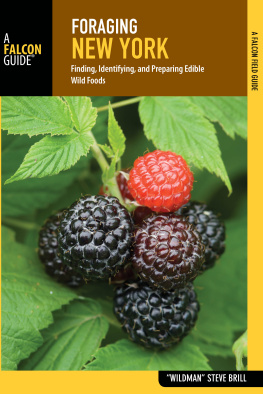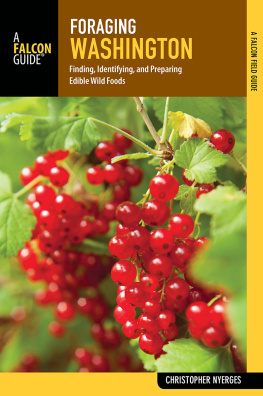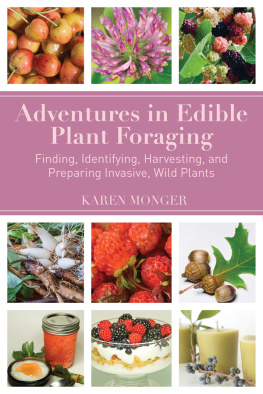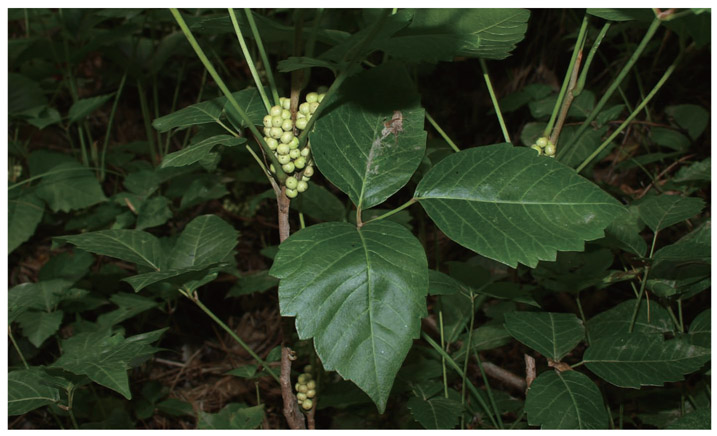ABOUT THE AUTHOR
Liz Brown Morgan is the founder of Backyard Agrarian and the inventor of TareWare. She is also a yoga teacher and a sustainability activist and writer. She has been a wilderness guide, a whitewater raft guide, a professional gardener, and an environmental lawyer. Liz holds a BA in native American studies, an MA in environmental law and policy, and a JD. Learn more or contact her at www.BackyardAgrarian.com.
ACKNOWLEDGMENTS
I am fantastically grateful for the generous assistance of several botanists, wild food specialists, herbalists, photographers and foragers. Learning about wild foods is a lifelong endeavor and my experience and research was supplemented with some incredible and much needed expertise. There is no end to the complexities, the wonders, and the questions that arise as you go deeper into the world of wild edibles, and the people below tackled my endless list of questions.
Rich Morgan, photographs and editing: An enormous thank you to my incredible husband. Rich has joined me on many foraging excursions and photo-taking sessions. He shares my enthusiasm for a wild and nature-oriented lifestyle, and he has been an honest and thoughtful editor and contributor to this book. Rich is a meticulous photographer and biologist and took many of the photographs for this book. He also taught me how to use a camera for the ones I took myself. Rich wrote the section on honeybees. His expertise in bees, photography, and beer brewing, and his background in plant identification, was enormously helpful. Most importantly, Rich reminded me to have fun with this book even as the deadline approached.
Denise C. Wilson: I count myself outrageously fortunate to have worked with Denise on this project. Denise patiently and generously pored over species identification keys to help me confirm the species depicted in the photos for this book. Denise is a professional botanist and has a masters in Integrated Science from the University of Colorado, Denver. She has collected seeds from 350 plant species for seed banking with the National Park Service and Bureau of Land Managements Seeds of Success Program, the Chicago Botanic Gardens Dixon National Tallgrass Prairie Seed Bank, and Kew Gardens Millennium Seed Bank Program. As an advocate for plant conservation, she has given fifty presentations worldwide from Honolulu to Nairobi. For more about Denise, visit her LinkedIn page: www.linkedin.com/in/denisecwilson.
John Duncan, Oso Negro School: John Duncan is the founder of the Oso Negro School in Taos, New Mexico. He is also an adjunct professor of Wild Food and Wild Medicine at the University of New Mexico, Taos. I sent draft after draft of this book to John, and the insights he came back with were the kinds of things you just cant find in books. John possesses a special depth of knowledge about wild foods, and the assistance he provided was truly extraordinary. If you are in northern New Mexico, you can contact John directly to schedule a nature walk or wildcrafting lesson. For more information visit www.OsoNegroSchool.com.
Katrina Blair, Turtle Lake Refuge: Katrina is the founder of the Turtle Lake Refuge in Durango, Colorado. Katrina and her mighty band of raw, wild foodists bring living the wild food life to extraordinary new heights. Katrina generously shared her wild food wisdom with me and helped answer some of the most difficult questions I had when trying to finalize this book. If you are in the Durango area, stop by to get inspired and pick up some wild snacks for the road. Katrinas cookbook, Local Wild Life: Turtle Lake Refuges Recipes for Living Deep, demonstrates her mastery of wild cuisine and is a must for any foragers bookshelf. Find more info at www.TurtleLakeRefuge.org.
Others also provided valuable assistance. Thanks to Marisa Heidt for helping me with the tree section. Marisa is an environmental educator and has worked for the City of Boulder as an urban forestry assistant and for the Boulder County arborist. Thanks also to Briggs Wallis, an herbalist, nutritionist, and natural health practitioner in Boulder, Colorado, for careful editing of plant uses. Jared Urchek (www.BoulderMushrooms.com) provided fascinating insight into wild mushrooms. Although we ended not including any mushrooms in the book, discussing mushrooms with Jared is always amazing. My thanks also goes to Julie Hayes for her thoughtful insights and editing assistance. And thanks to Andy Fischer (www.SacredEarthDesign.com) for taking the time to discuss wild foods in the context of permaculture.
Poisonous Plants
WARNING: Do not ingest any of the species in this chapter, as they are highly poisonous.
WESTERN POISON IVY
Toxicodendron rydbergii
Family: Anacardiaceae
Other names: Green western poison ivy, poison ivy, Rhus rydbergii
WARNING: Allergic contact dermatitis can occur when the skin comes in contact with poison ivy. This plant contains urushiol (as do poison sumac and poison oak), an oil that can cause a severe allergic reaction. Symptoms include hives, rash, swelling, itching, and pain. Redness, bumps, and large puss-filled blisters can also result.
For highly sensitive people, anaphylaxis can result. Anaphylaxis is very serious and results in the closing of the airways, often with a swelling in the throat, and can result in death. If you or anyone in your party begins to experience difficulty breathing or the throat starts to close, he or she should be taken to the hospital immediately.
Description
Western poison ivy is a low-growing rhizomatous perennial growing up to 4' tall. Leaves are alternate and compound, each consisting of three large, rounded leaflets. Leaflets are 1"6" long and 1"4" wide. They are usually shiny but otherwise can vary from fairly smooth to toothed to slightly lobed. Leaves turn from reddish when young to glossy green in summer. In fall they turn red, orange, or yellow.
Five-petaled, nondescript, cream or light greenish flower clusters along the leaf axils give way to white berries, or drupes. Each drupe is less than " in diameter and contains one seed.
Poison ivy often forms a dense ground cover and can span several square feet or even an acre.
Range and Habitat
Fertile, moist soil of all types from British Columbia throughout the United States except the southeastern states. From sea level up to 8,500' in elevation. Found along roadsides, on sand dunes, in forests and along forest edges, especially near creeks, ditches, and areas where floods sometimes occur.
Comments
The old saying about poison ivy, Leaflet three, let it be, is a good reminder not to touch this three-leaved plant. Related to eastern poison ivy (Toxicodendron radicans), which is very similar but is vine-like and climbs high into trees. Western poison ivy does not climb.
A salve or remedy against poison ivy can be made with gumweed (Grindelia squarrosa).
Take a lesson from my friend the coach, who washed clothes that had come into contact with poison ivy with a load of uncontaminated laundry. The toxic oil spread to everything. Every time he got dressed, the painful rash would reappear. Wearing his hat caused his eyes to swell shut, and he finally realized it was time for a new wardrobe.














